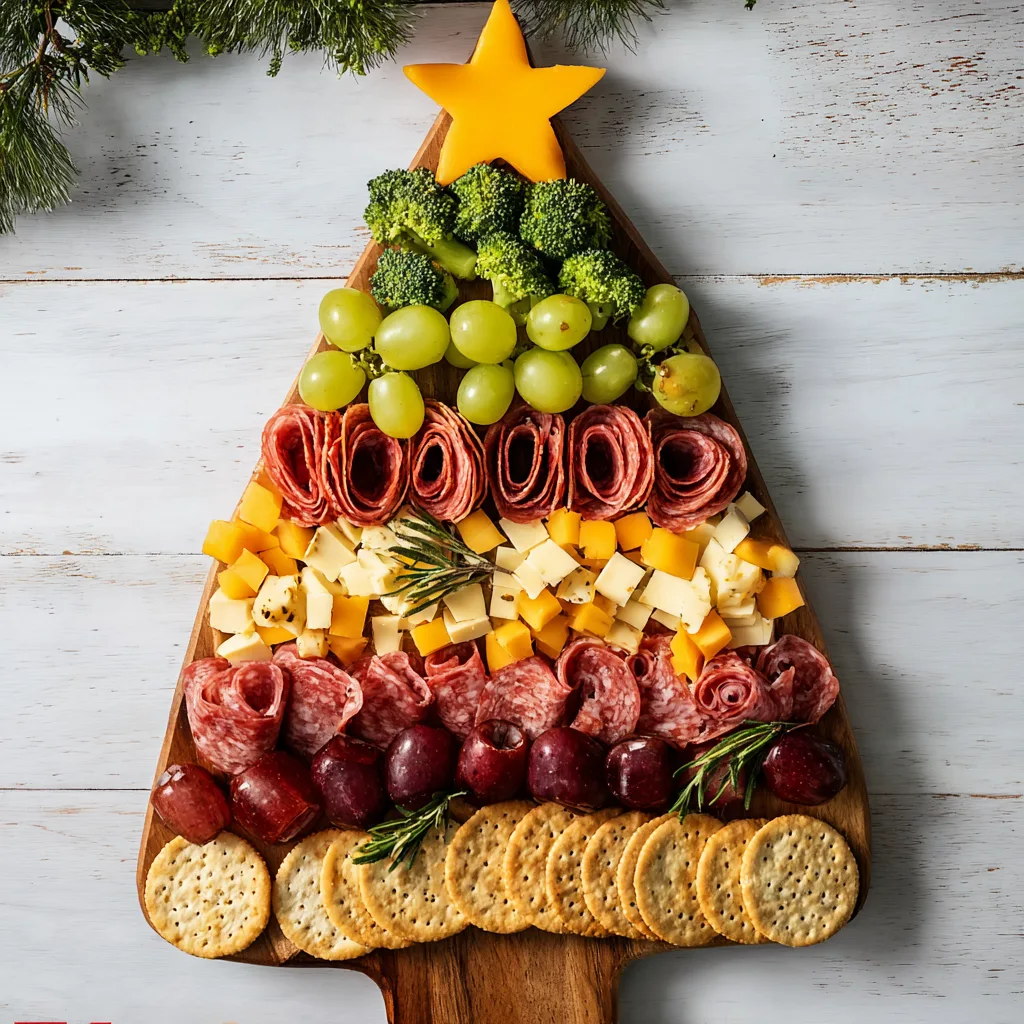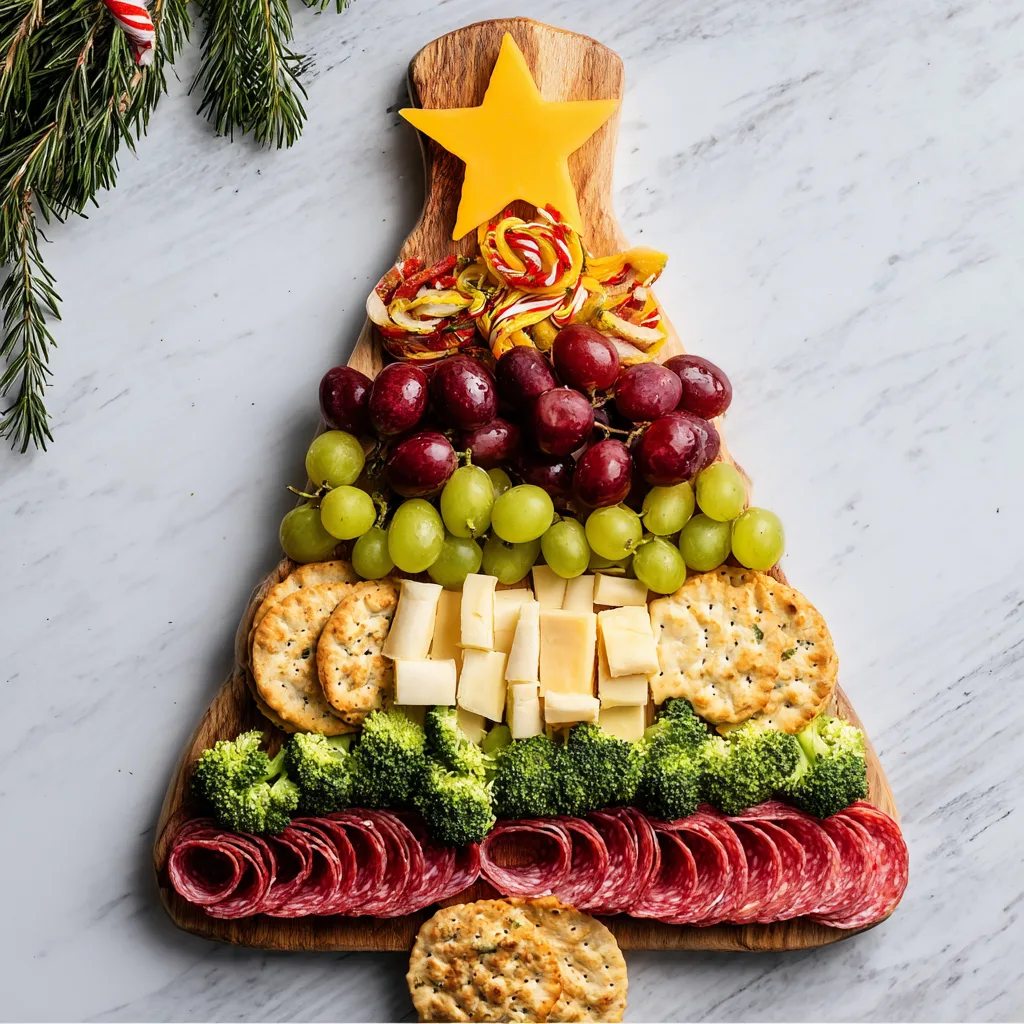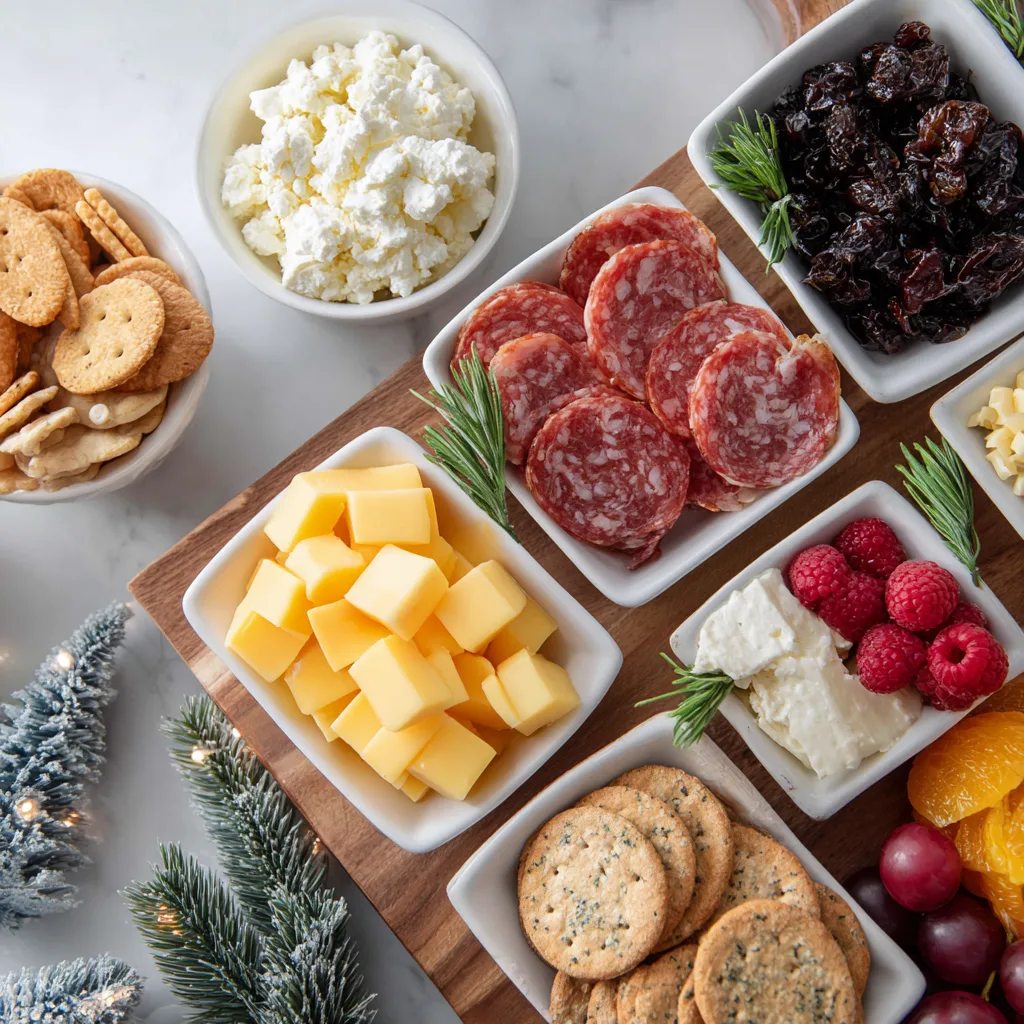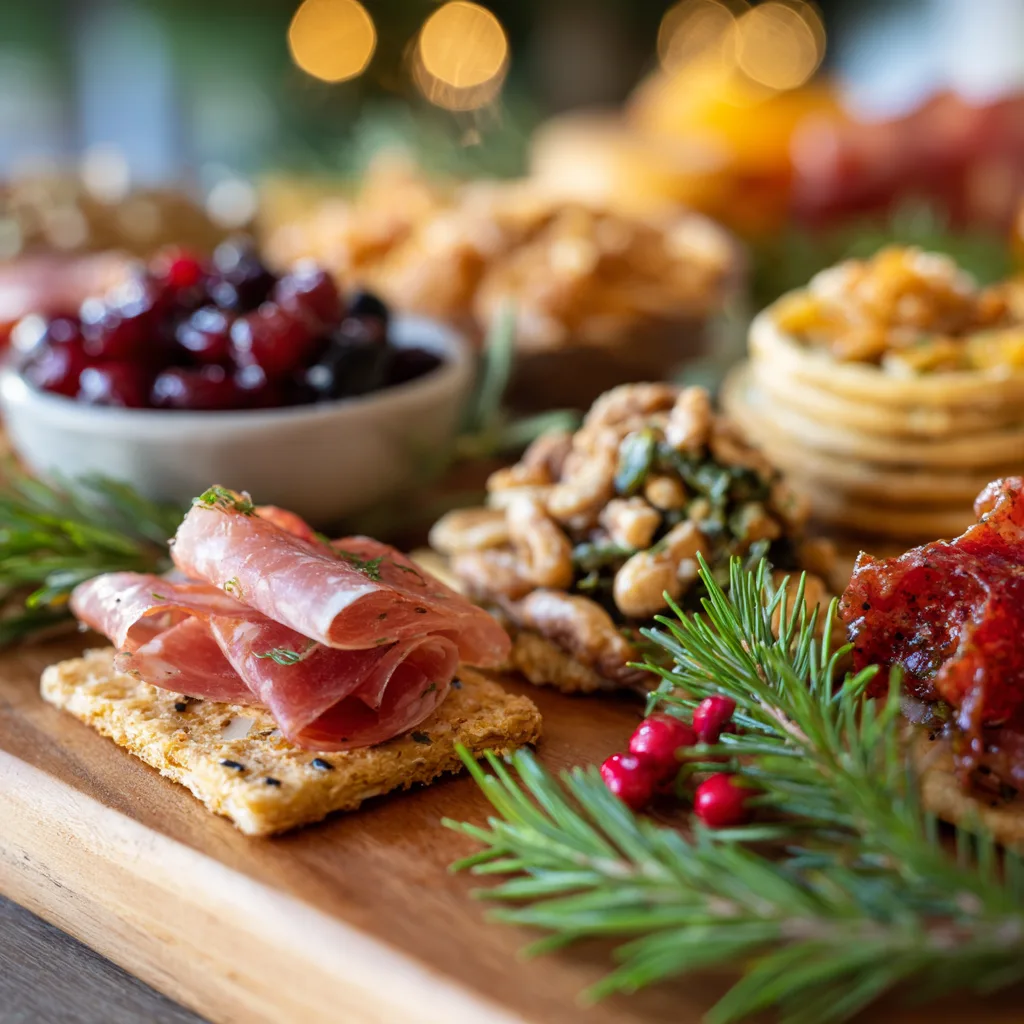Christmas Tree Charcuterie Board: The Art of Festive Entertaining Made Effortlessly Elegant
The holiday season calls for entertaining solutions that are both visually stunning and deliciously satisfying, and nothing quite achieves this balance like a thoughtfully crafted Christmas tree charcuterie board. This isn’t just an appetizer spread – it’s an edible centerpiece that transforms ordinary party foods into a festive work of art that guests will photograph before they devour.
This creative approach to charcuterie takes the traditional concept of cheese and meat boards and elevates it through strategic color coordination and artistic arrangement. By selecting foods based on their natural colors and arranging them in the iconic Christmas tree shape, you create an impressive display that requires no special cooking skills yet delivers maximum visual impact and flavor satisfaction.

The Philosophy of Charcuterie Board Design
Creating exceptional charcuterie boards requires understanding the principles of visual composition, flavor balance, and textural variety. The most successful boards operate on multiple levels simultaneously – they’re beautiful to look at, offer diverse flavor experiences, and provide practical eating solutions for groups of varying sizes and preferences.
Color theory plays a crucial role in charcuterie board success. The Christmas tree design leverages the natural green colors found in foods like grapes, olives, broccoli, and herbs to create the tree shape, while red elements like cherry tomatoes, strawberries, and red peppers serve as colorful “ornaments.” This natural color palette creates festive appeal without artificial ingredients or food coloring.
Texture variety ensures that every guest finds something appealing while preventing palate fatigue. The combination of creamy cheeses, crispy crackers, smooth spreads, crunchy vegetables, and tender meats creates a dynamic eating experience that keeps people engaged and satisfied throughout the gathering.
Strategic Ingredient Selection for Visual Impact
The success of a Christmas tree charcuterie board depends heavily on selecting ingredients based on both their natural colors and their ability to maintain visual appeal throughout the serving period. Green elements should retain their vibrant color without wilting or browning, while red accents need to hold their shape and brightness.
Broccoli florets work exceptionally well as the base “greenery” because their natural tree-like shape reinforces the Christmas tree illusion while providing satisfying crunch and mild flavor that appeals to most palates. Green grapes cluster beautifully and offer natural sweetness that balances savory elements, while their spherical shape suggests ornaments hanging from tree branches.
Cheese selection requires consideration of both color and cutting properties. White cheeses like fresh mozzarella or goat cheese can represent snow or white ornaments, while yellow cheeses can be cut into star shapes for tree toppers. Soft cheeses should be pre-cut or provided with appropriate spreading knives, while hard cheeses can be pre-sliced or left in wedges with proper cutting tools.

Assembly Techniques for Professional Results
Creating a visually stunning Christmas tree charcuterie board requires methodical planning and strategic assembly. Starting with the largest elements and working toward smaller details ensures proper proportion and prevents overcrowding that can make the board look chaotic rather than artfully arranged.
The foundation should be established first using larger items like cheese wedges and meat arrangements to create the basic tree outline. This skeletal structure provides reference points for placing smaller elements and ensures the tree shape remains clear throughout the assembly process. Working from the outside edges inward helps maintain clean lines and prevents accidental disruption of carefully placed elements.
Layering creates visual depth and interest while maximizing the board’s capacity. Overlapping meats in fan patterns, clustering similar items together, and creating height variations through strategic stacking transforms a flat arrangement into a three-dimensional display that looks professionally crafted.

Ingredients
Green Elements (Tree Base):
- 2 cups fresh broccoli florets
- 1 1/2 cups green grapes, clustered
- 1/2 cup green olives
- 8 oz sliced cucumber rounds
- Fresh basil sprigs
- 6 oz herb-crusted goat cheese
- Green apple slices (treated with lemon juice)
Red Elements (Ornaments):
- 1 1/2 cups cherry tomatoes
- 1 cup fresh strawberries
- 1/2 cup red grapes
- 4 oz salami or pepperoni, rolled
- Red bell pepper strips
- Dried cranberries
White/Yellow Elements (Snow & Star):
- 6 oz brie cheese, sliced
- 4 oz aged white cheddar, cubed
- 1/2 cup cashews or almonds
- Yellow bell pepper (for star)
- White crackers
Accompaniments:
- 2 cups assorted crackers
- Fig jam or honey
- Whole grain mustard
- Small serving spoons and cheese knives

Instructions
- Select a large wooden board or serving tray, preferably rectangular or oval shaped to accommodate the tree design.
- Begin by outlining the Christmas tree shape using larger green elements like broccoli florets and grape clusters to establish the basic triangular form.
- Create the tree trunk using rectangular crackers or cheese slices arranged vertically at the base of the triangle.
- Fill in the tree shape with remaining green elements, varying sizes and textures for visual interest. Place herb goat cheese strategically throughout.
- Add red “ornaments” by placing cherry tomatoes, strawberries, and rolled salami pieces evenly throughout the green tree sections.
- Tuck cucumber rounds and apple slices into gaps, ensuring they’re treated with lemon juice to prevent browning.
- Create “snow” effects by placing white cheese pieces and nuts in clusters throughout the tree design.
- Cut a star shape from yellow bell pepper and position it at the top of the tree as the crowning element.
- Fill any remaining spaces with appropriate crackers, ensuring easy access for guests to build their own combinations.
- Place small bowls of fig jam, honey, and mustard around the board’s perimeter for easy access.
- Add fresh basil sprigs and rosemary around the base and throughout the design for additional greenery and aromatic appeal.
- Provide small serving spoons, cheese knives, and small plates for guest convenience.
- Arrange additional crackers in baskets or bowls nearby to prevent overcrowding the main display.
- Cover with plastic wrap if making ahead, removing 30 minutes before serving to bring items to optimal temperature.
- Encourage guests to take photos before diving in, as the initial presentation is part of the experience.
This Christmas tree charcuterie board represents the perfect solution for holiday entertaining, combining stunning visual appeal with practical serving convenience and diverse flavor options. It transforms the simple act of sharing appetizers into a memorable centerpiece that brings guests together, encourages conversation, and creates those special moments that define the best holiday celebrations.

Christmas Tree Charcuterie Board
Ingredients
Equipment
Method
- Select a large wooden board or serving tray, preferably rectangular or oval shaped to accommodate the tree design.
- Begin by outlining the Christmas tree shape using larger green elements like broccoli florets and grape clusters to establish the basic triangular form.
- Create the tree trunk using rectangular crackers or cheese slices arranged vertically at the base of the triangle.
- Fill in the tree shape with remaining green elements, varying sizes and textures for visual interest. Place herb goat cheese strategically throughout.
- Add red ‘ornaments’ by placing cherry tomatoes, strawberries, and rolled salami pieces evenly throughout the green tree sections.
- Tuck cucumber rounds and apple slices into gaps, ensuring they’re treated with lemon juice to prevent browning.
- Create ‘snow’ effects by placing white cheese pieces and nuts in clusters throughout the tree design.
- Cut a star shape from yellow bell pepper and position it at the top of the tree as the crowning element.
- Fill any remaining spaces with appropriate crackers, ensuring easy access for guests to build their own combinations.
- Place small bowls of fig jam, honey, and mustard around the board’s perimeter for easy access.
- Add fresh basil sprigs and rosemary around the base and throughout the design for additional greenery and aromatic appeal.
- Provide small serving spoons, cheese knives, and small plates for guest convenience.
- Arrange additional crackers in baskets or bowls nearby to prevent overcrowding the main display.
- Cover with plastic wrap if making ahead, removing 30 minutes before serving to bring items to optimal temperature.
- Encourage guests to take photos before diving in, as the initial presentation is part of the experience.
Notes
Flavor Pairing and Harmony
While visual appeal drives the initial impact of a Christmas tree charcuterie board, sustained success depends on thoughtful flavor combinations that complement rather than compete with each other. The goal is creating harmonious taste experiences that encourage exploration while satisfying diverse preferences.
Classic charcuterie pairings translate beautifully to the Christmas tree format. Sharp aged cheeses pair wonderfully with sweet elements like grapes or dried fruits, while mild cheeses provide neutral bases that work with both sweet and savory accompaniments. Salty cured meats require balancing elements like fresh fruits or mild vegetables to prevent palate overwhelm.
Condiments and spreads play crucial supporting roles in flavor harmony. Fig jam or honey provides sweetness that bridges the gap between savory meats and mild cheeses, while whole grain mustard adds tangy complexity that enhances both cheese and meat flavors. These elements should be provided in small bowls with appropriate serving spoons to maintain board organization.
Dietary Accommodations and Inclusive Entertaining
Modern entertaining requires consideration of various dietary restrictions and preferences, and charcuterie boards offer excellent flexibility for accommodating diverse needs while maintaining visual appeal. The Christmas tree format actually enhances this flexibility by creating distinct sections that can be designated for different dietary requirements.
Vegetarian sections can feature various cheeses, fresh and dried fruits, vegetables, nuts, and crackers, creating substantial options for non-meat eaters. Gluten-free alternatives include vegetable crackers, cheese crisps, and naturally gluten-free items like fruits and vegetables. These accommodations can be seamlessly integrated into the tree design without creating obvious separated sections.
For guests with specific allergies, careful ingredient selection and clear labeling ensure safe enjoyment. Nut-free versions might substitute seeds for nuts, while dairy-free options could include plant-based cheese alternatives and plenty of fresh fruits and vegetables. The key lies in maintaining abundance and variety while respecting individual needs.






